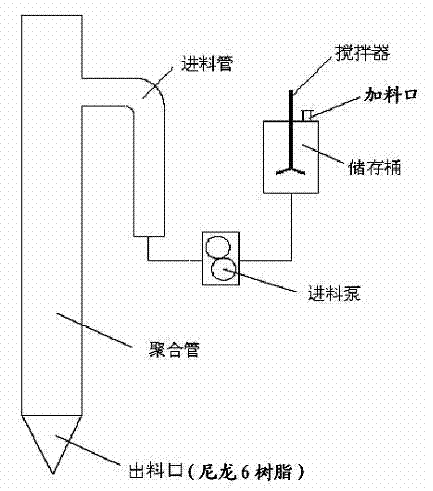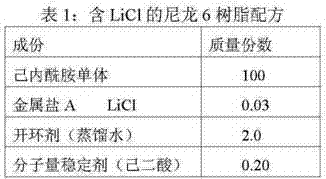Nylon-6 resin, nylon-6 filament and preparation method thereof
A technology of nylon and resin, applied in the field of spinning materials, to achieve the effects of enhanced tensile strength, stable and excellent performance, and cost reduction
- Summary
- Abstract
- Description
- Claims
- Application Information
AI Technical Summary
Problems solved by technology
Method used
Image
Examples
Embodiment 1
[0045]
[0046] like figure 1 Shown: Stir and mix the above materials in the storage tank evenly, and continuously send the above materials into the straight VK pipe through the feed pump, and the materials are polymerized by the ring-opening agent. The temperature control in the polymerization reaction is divided into three parts In the first stage, the material is in the upper section of the straight VK tube, and the temperature is controlled between 225-245°C; in the middle section of the straight VK tube, the temperature is controlled between 230-245°C; in the lower section of the straight VK tube, the temperature is controlled at 220-240°C In between, the polymer melt flows down to the bottom of the VK tube through layers of baffles, and is taken out by the discharge pump to maintain the liquid level in the tube. The polymerization time is 8 hours. The obtained polymer melt is washed with water, cut into pellets, and dried in vacuum to remove moisture and small molecul...
Embodiment 2
[0050]
[0051] like figure 1 Shown: Stir and mix the above materials in the storage tank evenly, and continuously send the above materials into the straight VK pipe through the feed pump, and the materials are polymerized by the ring-opening agent. The temperature control in the polymerization reaction is divided into three parts In the first stage, the material is in the upper section of the straight VK tube, and the temperature is controlled between 230 and 250°C; in the middle section of the straight VK tube, the temperature is controlled between 238 and 250°C; in the lower section of the straight VK tube, the temperature is controlled between 230 and 240°C In between, the polymer melt flows down to the bottom of the VK tube through layers of baffles, and is taken out by the discharge pump to maintain the liquid level in the tube. The polymerization time is 12 hours. The obtained polymer melt is washed with water, cut into pellets, and dried in vacuum to remove moisture...
Embodiment 3
[0055]
[0056] like figure 1Shown: Stir and mix the above materials in the storage tank evenly, and continuously send the above materials into the straight VK pipe through the feed pump, and the materials are polymerized by the ring-opening agent. The temperature control in the polymerization reaction is divided into three parts In the first stage, the material is in the upper section of the straight VK tube, and the temperature is controlled between 255 and 270°C; in the middle section of the straight VK tube, the temperature is controlled between 255 and 265°C; in the lower section of the straight VK tube, the temperature is controlled between 245 and 255°C In between, the polymer melt flows down to the bottom of the VK tube through layers of baffles, and is taken out by the discharge pump to maintain the liquid level in the tube. The polymerization time is 16 hours. The obtained polymer melt is washed with water, cut into pellets, and dried in vacuum to remove moisture ...
PUM
| Property | Measurement | Unit |
|---|---|---|
| diameter | aaaaa | aaaaa |
| pore size | aaaaa | aaaaa |
| length | aaaaa | aaaaa |
Abstract
Description
Claims
Application Information
 Login to View More
Login to View More - R&D
- Intellectual Property
- Life Sciences
- Materials
- Tech Scout
- Unparalleled Data Quality
- Higher Quality Content
- 60% Fewer Hallucinations
Browse by: Latest US Patents, China's latest patents, Technical Efficacy Thesaurus, Application Domain, Technology Topic, Popular Technical Reports.
© 2025 PatSnap. All rights reserved.Legal|Privacy policy|Modern Slavery Act Transparency Statement|Sitemap|About US| Contact US: help@patsnap.com



